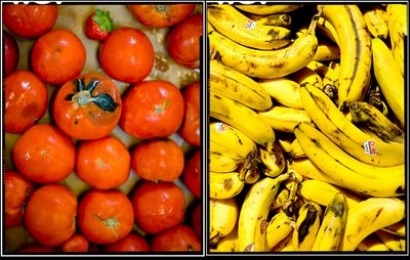Fraunhofer turns brown bananas and squashed tomatoes into useful biogas
Mushy tomatoes, brown bananas and overripe cherries – to date, waste from wholesale markets has ended up on the compost heap at best. However, researchers at the Fraunhofer Institute for Interfacial Engineering and Biotechnology IGB have developed a new facility that ferments this waste to make methane, which can be used to power vehicles.  Drivers who fill up with natural gas instead of gasoline or diesel spend less on fuel and are more environmentally friendly. Natural gas is kinder on the wallet, and the exhaust emissions it produces contain less carbon dioxide and almost no soot particles. As a result, more and more motorists are converting their gasoline engines to run on natural gas. But just like oil, natural gas is also a fossil fuel, and reserves are limited.
Drivers who fill up with natural gas instead of gasoline or diesel spend less on fuel and are more environmentally friendly. Natural gas is kinder on the wallet, and the exhaust emissions it produces contain less carbon dioxide and almost no soot particles. As a result, more and more motorists are converting their gasoline engines to run on natural gas. But just like oil, natural gas is also a fossil fuel, and reserves are limited.Now, though, researchers at the Fraunhofer Institute for Interfacial Engineering and Biotechnology IGB in Stuttgart (Germany) have developed an alternative: They have found a way to obtain this fuel not from the Earth’s precious reserves of raw materials, but from fruit and vegetable waste generated by wholesale markets, university cafeterias and canteens. Fermenting this food waste produces methane, also known as biogas, which can be compressed into high-pressure cylinders and used as fuel.
In early 2012, the researchers will begin operating a pilot plant adjacent to Stuttgart’s wholesale market. The facility uses various microorganisms to generate sought-after methane from the food waste in a two-stage digestion process that lasts just a few days.
“The waste contains a lot of water and has a very low lignocellulose content, so it’s highly suitable for rapid fermentation,” says Dr.-Ing. Ursula Schließmann, head of department at the IGB. But it still presents a challenge, because its precise composition varies every day. Sometimes it has a high proportion of citrus fruits, while other times there are more cherries, plums and lettuce. On days with a higher citrus fruit content, the researchers have to adjust the pH value through substrate management, because these fruits are very acidic.
“We hold the waste in several storage tanks, where a number of parameters are automatically calculated – including the pH value. The specially designed management system determines exactly how many litres of waste from which containers should be mixed together and fed to the microorganisms,” explains Schließmann. It is vital that a correct balance be maintained in the plant at all times, because the various microorganisms require constant environmental conditions to do their job.
Another advantage of the new plant lies in the fact that absolutely everything it generates can be utilized; the biogas plant, the liquid filtrate, and even the sludgy residue that cannot be broken down any further. A second sub-project in Reutlingen comes into its own here, involving the cultivation of algae. When the algae in question are provided with an adequate culture medium, as well as carbon dioxide and sunlight, they produce oil in their cells that can be used to power diesel engines. The filtrate water from the biogas plant in Stuttgart contains sufficient nitrogen and phosphorus to be used as a culture medium for these algae, and the reactor facility also provides the researchers with the carbon dioxide that the algae need in order to grow; while the desired methane makes up around two thirds of the biogas produced there, some 30 percent of it is carbon dioxide. With these products put to good use, all that is left of the original market waste is the sludgy fermentation residue, which is itself converted into methane by colleagues at the Paul Scherrer Institute in Switzerland and at the Karlsruhe Institute of Technology.
Others involved in this network project, which goes by the name of ETAMAX, include energy company EnBW Energie Baden-Württemberg and Daimler AG. The former uses membranes to process the biogas generated in the market-place plant, while the latter supplies a number of experimental vehicles designed to run on natural gas. The five-year project is funded to the tune of six million euros by the German Federal Ministry of Education and Research (BMBF). If all the different components mesh together as intended, it is possible that similar plants could in future spring up wherever large quantities of organic waste are to be found. Other project partners are the Fraunhofer Institute for Process Engineering and Packaging IVV in Freising, FairEnergie GmbH, Netzsch Mohnopumpen GmbH, Stulz Wasser- und Prozesstechnik GmbH, Subitec GmbH und the town Stuttgart.














.jpg)